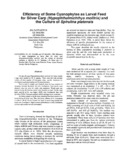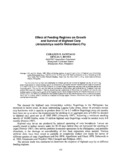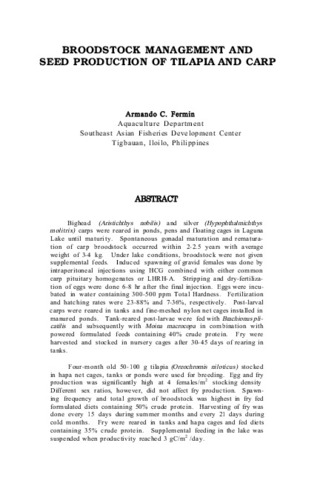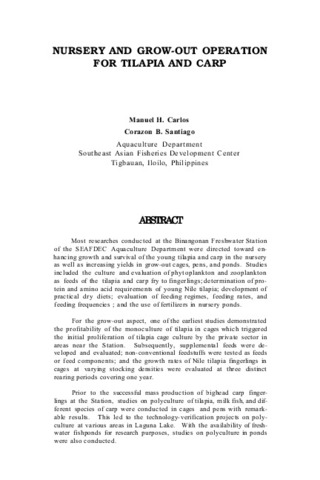Efficiency of some cyanophytes as larval feed for silver carp (Hypophthalmichthys molitrix) and the culture of Spirulina platensis

ရှာဖွေ/ဖွင့်ပါ။
ရက်စွဲ
1986Page views
702
Share
စိတ္တဇ
Six-day old carp (Hypophthalmichthys molitix) fry (mean weight 3 mg) were stocked at 5/l in aquaria. These were fed with unialgal cultures of three species of blue-green algae, namely: Anabaena sp., Oscillatoria quadripunctulata and Spirulina platensis. Best increase in weight was obtained when feeding consisted of Spirulina followed by those fed with Oscillatoria. Poor results were obtained when fry were fed solely with Anabaena. Weight gain was highest during the first two weeks with Spirulina as feed. On the other hand, survival of fry was higher (68%) with Oscillatoria than with Spirulina (54%). Proximate analysis of fish and algae were conducted. Spirulina seemed to be the most promising live food organism for larval rearing of silver carp. Thus, laboratory culture of the cyanophyte at different pH (9, 10 and 11) and two types of media (hog manure and urea) were investigated. Algal biomass production in a semi-continuous, outdoor tank system was also determined.
ဘာသာရပ်
စုစည်းမှုများ စုစည်းမှုများ
Related items
Showing items related by title, author, creator and subject.
-
Effect of feeding regimes on growth and survival of bighead carp (Aristichthys nobilis Richardson) fry
Santiago, Corazon B.; Reyes, Ofelia S. (Asian Fisheries Society, 1989)Two five-week feeding trials were undertaken to evaluate growth and survival of bighead carp (Aristichthys nobilis ) fry of 1.9-2.4 mg mean weight reared on various feeding regimes. In Treatment 1, the carp fry were fed ... -
Broodstock management and seed production of tilapia and carp
Fermin, Armando C. (Aquaculture Department, Southeast Asian Fisheries Development Center, 1988)Bighead (Aristichthys nobilis) and silver (Hypophthalmichthys molitrix) carps were reared in ponds, pens and floating cages in Laguna Lake until maturity. Spontaneous gonadal maturation and rematuration of carp broodstock ... -
Nursery and grow-out operation for tilapia and carp
Carlos, Manuel H.; Santiago, Corazon B. (Aquaculture Department, Southeast Asian Fisheries Development Center, 1988)Most researches conducted at the Binangonan Freshwater Station of the SEAFDEC Aquaculture Department were directed toward enhancing growth and survival of the young tilapia and carp in the nursery as well as increasing ...



